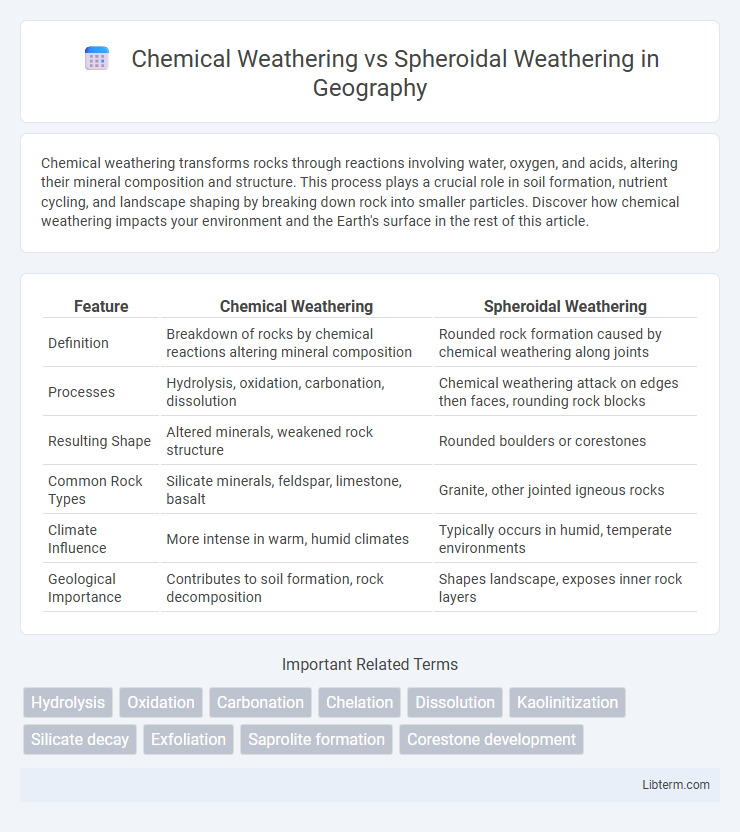Chemical weathering transforms rocks through reactions involving water, oxygen, and acids, altering their mineral composition and structure. This process plays a crucial role in soil formation, nutrient cycling, and landscape shaping by breaking down rock into smaller particles. Discover how chemical weathering impacts your environment and the Earth's surface in the rest of this article.
Table of Comparison
| Feature | Chemical Weathering | Spheroidal Weathering |
|---|---|---|
| Definition | Breakdown of rocks by chemical reactions altering mineral composition | Rounded rock formation caused by chemical weathering along joints |
| Processes | Hydrolysis, oxidation, carbonation, dissolution | Chemical weathering attack on edges then faces, rounding rock blocks |
| Resulting Shape | Altered minerals, weakened rock structure | Rounded boulders or corestones |
| Common Rock Types | Silicate minerals, feldspar, limestone, basalt | Granite, other jointed igneous rocks |
| Climate Influence | More intense in warm, humid climates | Typically occurs in humid, temperate environments |
| Geological Importance | Contributes to soil formation, rock decomposition | Shapes landscape, exposes inner rock layers |
Introduction to Weathering Processes
Chemical weathering involves the breakdown of rocks through chemical reactions, such as oxidation, hydrolysis, and carbonation, altering the mineral composition and weakening rock structures. Spheroidal weathering is a specific form of chemical weathering that affects jointed bedrock, causing the rock to break down into rounded, concentric layers due to differential chemical dissolution along edges and corners. Both processes play crucial roles in shaping landscapes by transforming solid rock into soil and sediment through chemical alterations.
Defining Chemical Weathering
Chemical weathering involves the breakdown of rocks through chemical reactions, primarily involving water, acids, and gases that alter the mineral composition of the rock. Spheroidal weathering is a specific type of chemical weathering characterized by the rounding of rock edges and corners due to the differential dissolution of minerals along joints and fractures. This process typically results in the formation of smooth, rounded boulders from blocky rock masses.
What is Spheroidal Weathering?
Spheroidal weathering is a type of chemical weathering that specifically targets the edges and corners of rock blocks, causing the outer layers to peel away in rounded, concentric shells. This process occurs due to the differential penetration of water and chemical reactions along fractures, leading to the progressive rounding and smoothing of angular rock masses. As a subset of chemical weathering, spheroidal weathering profoundly influences the shaping of granite and other coarse-grained igneous rocks.
Key Differences Between Chemical and Spheroidal Weathering
Chemical weathering involves the breakdown of rocks through chemical reactions such as hydrolysis, oxidation, and carbonation, altering the mineral composition and structure. Spheroidal weathering is a specific form of chemical weathering that rounds off rock edges and corners, creating a spherical shape due to differential weathering rates along joints and fractures. Key differences include the process scope, with chemical weathering encompassing various reactions affecting entire mineral matrices, while spheroidal weathering is distinguished by its geometric impact on rock shapes.
Mechanisms of Chemical Weathering
Chemical weathering involves the breakdown of rocks and minerals through chemical reactions such as hydrolysis, oxidation, and dissolution, which alter the mineral composition and weaken rock structure. Spheroidal weathering is a specific form of chemical weathering where water penetrates rock joints, promoting chemical alteration and rounding of angular rock blocks into spheroidal shapes. The primary mechanisms driving chemical weathering include the interaction of water with minerals, leading to changes such as feldspar transforming into clay minerals and iron oxidation causing rust-like staining.
The Formation Process of Spheroidal Weathering
Spheroidal weathering forms through chemical weathering processes that selectively decompose minerals along rock joints and fractures, leading to rounding of angular blocks into spheroids. Water infiltrates these joints, promoting hydrolysis and oxidation reactions that break down feldspar and other susceptible minerals, causing volume reduction and surface rounding. This weathering is most pronounced in homogeneous, coarse-grained rocks such as granite, where concentric layers peel off progressively, a process known as exfoliation, characteristic of spheroidal weathering.
Environments Favoring Chemical Weathering
Environments favoring chemical weathering typically include warm, humid climates where increased temperature and moisture accelerate the breakdown of minerals through hydrolysis, oxidation, and dissolution processes. Tropical rainforests and other regions with abundant rainfall and consistent warmth provide ideal conditions for intense chemical weathering, leading to soil formation rich in clays and oxides. In contrast, spheroidal weathering often occurs in similar moist conditions but specifically affects jointed bedrock, causing rounded rock surfaces due to chemical decomposition along fracture planes.
Rock Types Prone to Spheroidal Weathering
Spheroidal weathering primarily affects igneous rocks such as granite and basalt due to their jointed, coarse-grained texture, which facilitates concentric peeling and rounding of rock edges. In contrast, chemical weathering involves broader geochemical processes that alter minerals in various rock types, including sedimentary rocks like limestone and shale. The susceptibility of rocks to spheroidal weathering depends on mineral composition, joint spacing, and the presence of water promoting hydrolysis and oxidation reactions.
Geological Significance and Impacts
Chemical weathering involves the breakdown of minerals through chemical reactions with water, oxygen, and acids, significantly altering rock composition and contributing to soil formation. Spheroidal weathering, a subset of chemical weathering, specifically targets the edges and corners of rock blocks, leading to rounded boulders and spheroidal shapes, which indicate advanced stages of weathering in geological formations. Both processes play crucial roles in landscape evolution, nutrient cycling, and the long-term stability of rock structures in various environments.
Summary: Comparing Chemical and Spheroidal Weathering
Chemical weathering involves the alteration of minerals through chemical reactions such as hydrolysis, oxidation, and dissolution, leading to the breakdown of rock material at a molecular level. Spheroidal weathering is a specific form of chemical weathering where jointed bedrock undergoes concentric peeling, producing rounded boulder shapes often seen in granitic terrains. Both processes play a critical role in soil formation and landscape evolution, but spheroidal weathering is distinguished by its characteristic rounded rock morphology resulting from differential chemical breakdown along fractures.
Chemical Weathering Infographic

 libterm.com
libterm.com